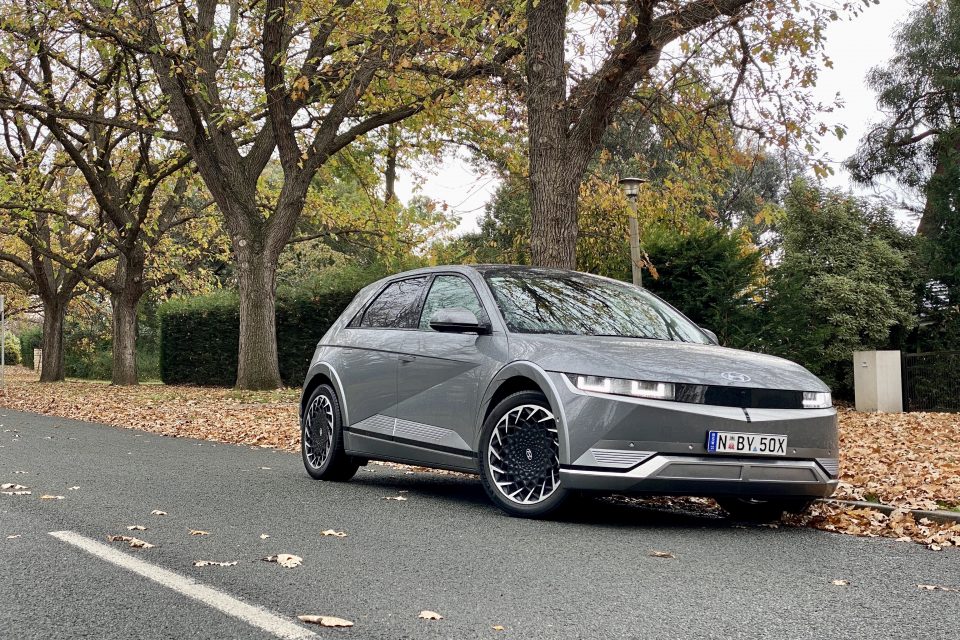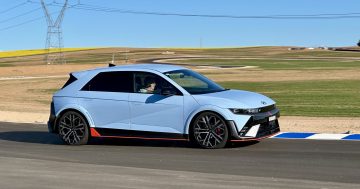
Hyundai IONIQ 5 in the tree-lined streets of Forrest. Photos: James Coleman.
I thought it was a hatchback at first. But as I painstakingly guide the car along the gutter, ever mindful of the Lazy-Susan-sized ‘low-drag’ wheels, I realise there’s nothing small about the new Hyundai IONIQ 5.
To make matters worse, I’m in Forrest, or Canberra’s ‘Garden City’. It’s one of the few suburbs that made its way into Walter Burley Griffin’s original plans for the new capital. It was originally gazetted as ‘Blandfordia’ and home to well-heeled public servants from Melbourne.
This was back when gum trees were distasteful so the roads were lined with towering deciduous trees, spreading their limbs overhead to form tunnels of colour and grandeur. It’s an incredibly pretty place.

Everyone will be looking.
However, on this particular drizzly autumn day, all of those leaves have decided to fall off. The gutters are nigh invisible.
The real reason I’m in Forrest is because the Region Media office is just around the corner and the Hyundai says I have 20 per cent charge left in the battery. I’m not going far with that.
True, there’s a fast-charging station just down the road in Manuka which would bring it back to full in less than an hour, but time is money and car reviews don’t write themselves. I also wouldn’t be in this predicament if charging it back at home didn’t require asking a neighbour very nicely if I might drape an extension lead across the apartment complex’s driveway and through his living room to the power point in his kitchen.
Yeah, we still have some way to go before every man and his dog is driving an electric vehicle.
There is also the matter of price. The original Hyundai IONIQ Electric debuted in 2016 as a five-door hatchback that looked eerily similar to the Toyota Prius. Pricing started at $50,000. As we’ve ascertained, the new IONIQ 5 is now more SUVish, starting at $71,900 for the single-motor, rear-wheel-drive version. I’m in the dual-motor all-wheel-drive and that will be $75,900, thank you very much.
Is it worth it? We all know running costs will virtually be a thing of the past, but I’m talking about the car itself. This is Tesla money, bear in mind, for a Hyundai.






As you’d expect from Burley-Griffin, the streets in Forrest are all laid out in circular and geometric patterns. It is incredibly easy to get lost. But that’s the beauty of it – Forrest is such a nice place to be, you don’t mind. And in the IONIQ 5, I mind even less. Rest assured, this car feels every bit special.
There’s the styling which – while making it appear deceptively small – is very cool. Everyone looks, and even I found myself pressing the lock and unlock buttons just so I could see those space-age front lights come on again.
Every Hyundai nowadays does seem to have been designed in a different postcode from the other, but in a way, I like that. There’s no cookie-cutter. Every Hyundai model is unique (the Staria is more proof of that).

Clouds also come in white, and they’re just as nice to ride.
The novelty continues inside, where natural light pours through a panoramic sunroof onto hectares of white leather trimmed in red piping with marble-look vinyl on the doors. The infotainment system, shared with Kia and Hyundai’s luxury brand Genesis, has even scored a whitewash, a clean and neat change from the black hole in many dashboards.
This is a beautiful place to be: sitting in the IONIQ makes you wonder where the harp and singing angels are. It is cloud-like. There are even adjustable footrests for the driver and passenger.
For years, Hyundai has also made a point of tuning all of their suspension setups here in Australia because of our woeful roads, and it has paid off royally. Bumps, big or small, are just soaked up.
There are three drive modes, Eco, Normal and Sport. Slip it into the latter, the dials glow red, and you can be at 100 km/h in … oh, blast.
Does electricity come in a jerry can, by any chance?

Nature lay a carpet for the occasion.
2022 Hyundai IONIQ 5
- $75,900
- Dual electric motors, 225 kW / 605 Nm
- All-wheel drive
- 0-100 km/h in 5.2 seconds
- 430 km estimated range
- 2,100 kg
This car was provided for testing by Hyundai Australia. Region Media has no commercial arrangement with Hyundai Australia.





















